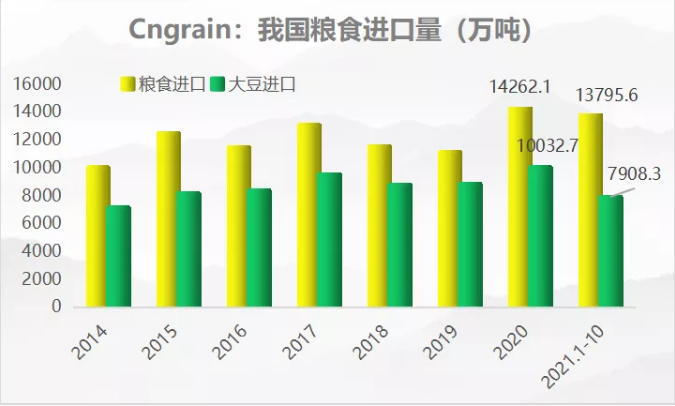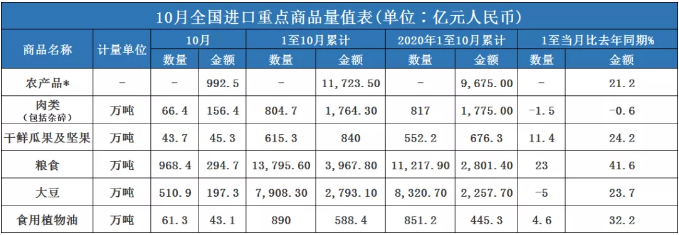———— Time:2021-11-18 Edit:互联网 Number of times read:62 ————
China's grain imports from January to October reached 138 million tons!
On November 7, data released by the GeneralAdministration of Customs showed that China's grain imports in October were9.684 million tons, and imports from January to October were 13.756 milliontons, an increase of 23% year-on-year, accounting for nearly 20% of China'stotal grain output. It is expected to exceed the total grain imports in 2020 of1426.621 million tons.


data Source: China Customs
Among them, soybean imports in October were5.109 million tons. Soybean imports from January to October were 79.083 milliontons, a decrease of 5% year-on-year, and the average import price was 3531.8 RMBper ton, an increase of 30.2%;
The import volume of edible vegetable oilin October was 613,000 tons, and the import volume of edible vegetable oil fromJanuary to October was 8.9 million tons, an increase of 4.6% year-on-year.
Soybean imports fell to thelowest level in 7 months
As the world’s largest buyer of soybeans,low extraction profits have curbed demand, and Hurricane Ida restricted USsoybean exports. In October, China’s soybean imports fell by 41.2% from 8.69million tons in the same period of the previous year to March 2020. Thelowest level since then, and also lower than the 6.88 million tons importedin September, a drop of 25.7%.
Earlier this year, as the hog market isexpected to recover rapidly and demand is strong, Chinese processing plantshave increased their procurement efforts. But after the oversupply of hog,demand declined, causing prices to plummet and reducing swineherd' profits.Throughout the summer, swineherd faced severe losses, although hog pricespicked up in October. At the beginning of September, soybean extraction profitsremained negative after hitting a record low in June. However, due to thedecline in inventories, profits improved in September.
Global grain prices rise totheir highest point in 10 years
The latest monthly report released by theFood and Agriculture Organization of the United Nations on November 4 pointedout that the FAO Food Price Index has been rising for three consecutive months,reaching the highest level since July 2011 in October. The FAO Food Price Indexfor the month averaged 133.2 points, a month-on-month increase of 3.0% and ayear-on-year increase of 31.3%.
Among them, the global wheat, corn and riceprices have strengthened. The FAO Cereal Price Index averaged 137.1 points inOctober, a month-on-month increase of 3.2% and a year-on-year increase of 22.4%.
Wheat: World wheat prices have risen forthe fifth consecutive month. In October, prices have climbed to their highestpoint since November 2012.
Coarse grains: World corn pricesstrengthened in October supported by the rise in the energy market, andinternational barley prices ranked first.
Rice: International rice prices continuedto rise slightly in October.
China's rations areabsolutely safe
The current food security situation inChina is generally good, and the domestic food market supply is fullyguaranteed, which can ensure that the food supply during important periods isnot out of stock or vacant.
Since the beginning of this year, China hasanchored its goal of stabilizing and increasing grain production. The currentgrain harvest is a foregone conclusion, and the output will remain above 1.3trillion catties for seven consecutive years.
In terms of inventory, China’s currentgrain inventory is at a historically high level, well above the internationalfood security warning line. The two major rations of wheat and rice account formore than 70% of the total inventory. Wheat stocks can meet consumer demand formore than one and a half years, and the annual balance of rice is about 30billion catties, ensuring that "grain is basically self-sufficient andrations are absolutely safe." In addition, China has actively establishedan emergency mechanism in which central reserves and local reserves, governmentreserves and corporate reserves complement each other and develop coordinateddevelopment, effectively enhancing risk prevention capabilities.
China's grain and oil market system anddistribution and supply network are sound, and rice flour oil can be quicklyput into the end consumer market. There are more than 5,500 food emergencyprocessing companies, more than 40,000 food supply outlets, more than 2,800food emergency distribution centers, more than 3,000 food emergency storage andtransportation companies. The guaranteed ability of finished grain and oilinventory is more than 20 days in 36 large and medium-sized cities and marketvolatile areas. The grain and oil processing capacity is very strong. It canprocess 1.5 million tons of rice and 800,000 tons of wheat per day. If oneperson eats half a kilogram of grain a day, the rice noodles processed in oneday will be enough for the people of the whole country to eat for two days.
Source: China Customs, Wenhua Finance,Economic Daily, Xinhua News Agency